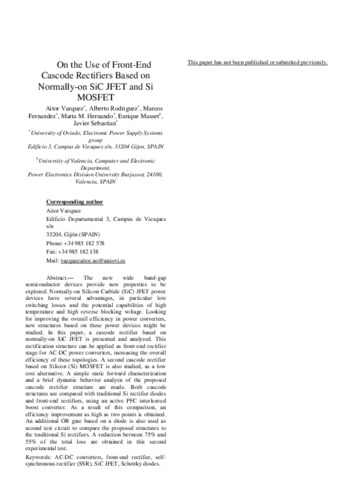On the use of front-end cascode rectifiers based on normally on SiC JFET and Si MOSFET
Fecha de publicación:
Editorial:
IEEE
Versión del editor:
Citación:
Descripción física:
Resumen:
The new wide band-gap semiconductor devices provide new properties to be explored. Normally on silicon carbide (SiC) JFET power devices have several advantages, in particular low switching losses and the potential capabilities of high temperature and high reverse blocking voltage. Looking for improving the overall efficiency in power converters, new structures based on these power devices might be studied. In this paper, a cascode rectifier based on normally on SiC JFET is presented and analyzed. This rectification structure can be applied as front-end rectifier stage for ac-dc power converters, increasing the overall efficiency of these topologies. A second cascode rectifier based on silicon (Si) MOSFET is also studied, as a low-cost alternative. A simple static forward characterization and a brief dynamic behavior analysis of the proposed cascode rectifier structure are made. Both cascode structures are compared with traditional Si rectifier diodes and front-end rectifiers, using an active power factor corrector (PFC) interleaved boost converter. As a result of this comparison, an efficiency improvement as high as two points is obtained. An additional OR gate based on a diode is also used as second test circuit to compare the proposed structures to the traditional Si rectifiers. A reduction between 75% and 55% of the total loss are obtained in this second experimental test
The new wide band-gap semiconductor devices provide new properties to be explored. Normally on silicon carbide (SiC) JFET power devices have several advantages, in particular low switching losses and the potential capabilities of high temperature and high reverse blocking voltage. Looking for improving the overall efficiency in power converters, new structures based on these power devices might be studied. In this paper, a cascode rectifier based on normally on SiC JFET is presented and analyzed. This rectification structure can be applied as front-end rectifier stage for ac-dc power converters, increasing the overall efficiency of these topologies. A second cascode rectifier based on silicon (Si) MOSFET is also studied, as a low-cost alternative. A simple static forward characterization and a brief dynamic behavior analysis of the proposed cascode rectifier structure are made. Both cascode structures are compared with traditional Si rectifier diodes and front-end rectifiers, using an active power factor corrector (PFC) interleaved boost converter. As a result of this comparison, an efficiency improvement as high as two points is obtained. An additional OR gate based on a diode is also used as second test circuit to compare the proposed structures to the traditional Si rectifiers. A reduction between 75% and 55% of the total loss are obtained in this second experimental test
Identificador local:
20141140
Patrocinado por:
This work was supported by the Spanish Government under Project MICINN-10-DPI2010-21110-C0201 and Project CONSOLIDER MICINN-10-CSD2009-00046 and by the FPU student Grant AP2008-03380 and FPI Grant BES-2011-044114
Colecciones
Ficheros en el ítem




